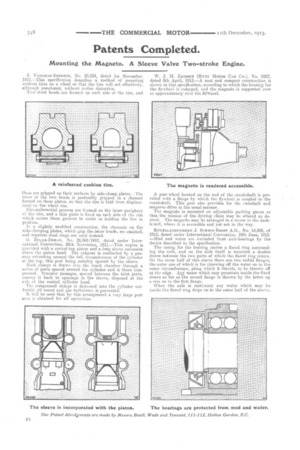Patents Completed.
Page 26

If you've noticed an error in this article please click here to report it so we can fix it.
Mounting the Magneto. A Sleeve Valve Two-stroke Engine.
J. VAUGHAN-SHEBA:LIN, No. 25,034, dated 1st November, 1912.—This specification describes a method of mounting cushion tires on a wheel so that the tire will act effectively, although punctured, without undue distortion.
Two stout beads are formed op each side of the tire, and these are gripped on their surfaces by side-clamp,.plates... The inner of the two beads is preferably ,gripped in a channel formed on these plates, so that the tire is held from displacement on the wheel rim.
Circumferential grooves are formed on the inner periphery of the tire, and a thin plate is fixed on each side of the rim which enters these grooves to assist in holding the tire in position.
In a slightly modified construction, the channels on the side-clamping plates, which grip the ir.rier beads, are omitted, and separate steel rings are us-ed instead.
G. DOLNE-DETIAN, No. 26,988/1912, dated under International Convention, 24th November, 1911.—This engine is provided with a conical-top piston and a long sleeve extension above the piston head. The exhaust is conducted by a. passage extending around the full circumference of the cylinder at the top, this port being suitably opened by the sleeve. Each charge is drawn into the crank chamber through a series of ports spaced around the cylinder and is there compressed. Transfer passages, spaced between the inlet ports, convey it back to openings in the sleeve, disposed at the side of the conical cylinder head. The compressed charge is delivered into the cylinder uniformly all round and gas turbulence is prevented. It will be seen that by this arrangement a very large port area is obtained for all operations.
W. J. M. JACMON (HUPP MOTOR CAR CO.), No. 8257, dated 8th April, 1913.—A neat and compact construction is shown in this specification, according to which the housing for the flywheel is enlarged, and the magneto is supported over or approximately over the flywheel.
A gear-wheel located on the end of the crankshaft is provided with a flange by which the flywheel is coupled to the crankshaft. This gear also provides for the camshaft and magneto-drive in the usual manner.
The magneto is mounted on adjustable packing pieces so that the tension of the driving chain may be altered as desired. The magneto may be arranged in a recess in the dashbeard, where it is accessible and yet not in the way.
KITGELLAGERWEELKE J. Surmm-Roon A.G., N. 14,095, of 1913, dated under International Convention, 19th June, 1912. —Mud and water are excluded from axle-bearings by the device described in the specification.
The casing for the bearing carries a flared ring surrounding the axle, and on the axle itself is mounted a double sleeve between the two parts of which the flared ring enters. On the inner half of this sleeve there are two radial flanges, the outer one of which is for throwing off the water on to the outer circumference, along which it ttavels, to be thrown off at the edge. fsay water which may penetrate inside the fixed sleeve as far as he second flange is thrown by the latter up a rise on to the first flange. When the axle is stationary any water which may ba inside the flared ring drips en to the outer half of the sleeve,.


























